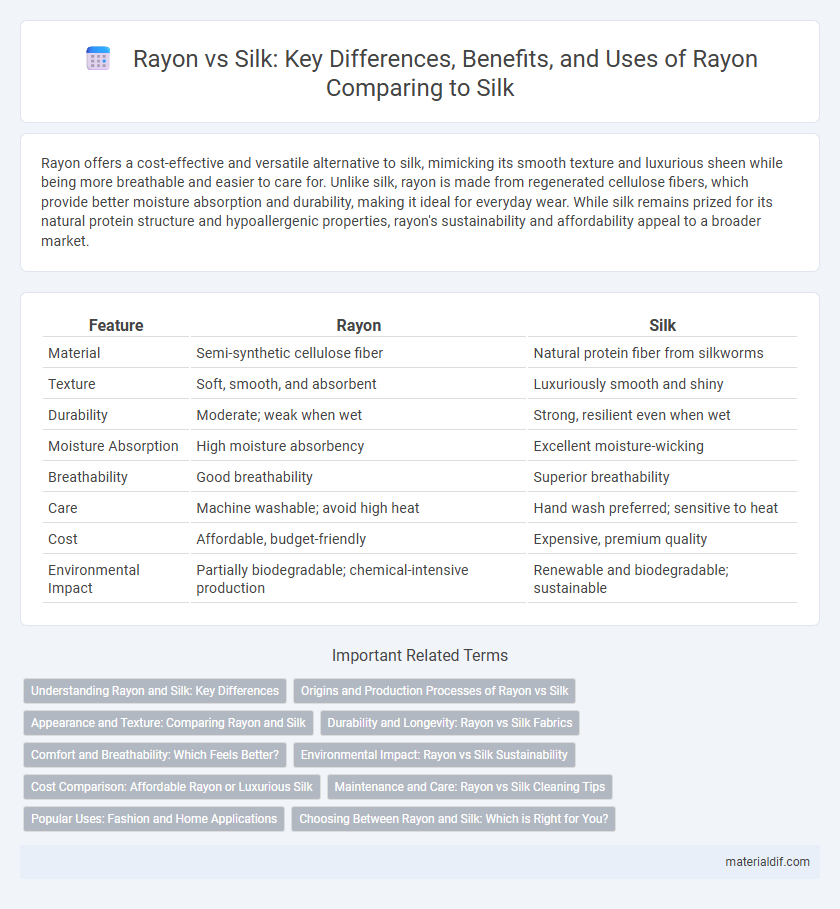Rayon offers a cost-effective and versatile alternative to silk, mimicking its smooth texture and luxurious sheen while being more breathable and easier to care for. Unlike silk, rayon is made from regenerated cellulose fibers, which provide better moisture absorption and durability, making it ideal for everyday wear. While silk remains prized for its natural protein structure and hypoallergenic properties, rayon's sustainability and affordability appeal to a broader market.
Table of Comparison
| Feature | Rayon | Silk |
|---|---|---|
| Material | Semi-synthetic cellulose fiber | Natural protein fiber from silkworms |
| Texture | Soft, smooth, and absorbent | Luxuriously smooth and shiny |
| Durability | Moderate; weak when wet | Strong, resilient even when wet |
| Moisture Absorption | High moisture absorbency | Excellent moisture-wicking |
| Breathability | Good breathability | Superior breathability |
| Care | Machine washable; avoid high heat | Hand wash preferred; sensitive to heat |
| Cost | Affordable, budget-friendly | Expensive, premium quality |
| Environmental Impact | Partially biodegradable; chemical-intensive production | Renewable and biodegradable; sustainable |
Understanding Rayon and Silk: Key Differences
Rayon is a semi-synthetic fiber made from regenerated cellulose, offering affordability and breathability, while silk is a natural protein fiber produced by silkworms, prized for its luxurious texture and sheen. Rayon absorbs moisture well but tends to wrinkle and lose strength when wet, whereas silk provides excellent elasticity and durability with a smooth, hypoallergenic surface. The production of rayon involves chemical processing of wood pulp, contrasting with the labor-intensive harvesting of silk cocoons, making each fiber unique in environmental impact and performance.
Origins and Production Processes of Rayon vs Silk
Rayon is a semi-synthetic fiber derived from cellulose extracted from wood pulp, where the production involves chemically dissolving the pulp to create viscose before spinning into fibers. Silk originates from the natural secretion of silkworms, undergoing a labor-intensive process of harvesting cocoons and unwinding silk filaments without chemical alteration. While rayon production relies heavily on industrial chemical processes and wood pulp, silk production depends on sericulture and natural fiber extraction, resulting in distinct textures and environmental footprints.
Appearance and Texture: Comparing Rayon and Silk
Rayon mimics the smooth, glossy appearance of silk but often lacks the natural luster and depth that pure silk fibers provide. Silk features a soft, luxurious texture with a natural sheen and a smooth, cool touch, while rayon offers a similarly soft feel but can sometimes appear more matte and less refined. Both materials drape well, but silk generally maintains a more elegant, fluid movement due to its protein fiber structure.
Durability and Longevity: Rayon vs Silk Fabrics
Rayon, made from regenerated cellulose fibers, offers moderate durability but tends to weaken when wet, whereas silk, a natural protein fiber, boasts superior tensile strength and resilience, making it more durable over time. Silk fibers resist stretching and abrasion better than rayon, contributing to its longer fabric lifespan under regular wear conditions. While rayon provides a cost-effective and versatile alternative, silk's natural strength and longevity make it a preferred choice for high-quality, long-lasting garments.
Comfort and Breathability: Which Feels Better?
Rayon offers superior breathability compared to silk due to its moisture-absorbing cellulose fibers, making it ideal for warm climates and active wear. Silk provides a luxurious smoothness and natural temperature regulation but can feel less breathable in humid conditions. When prioritizing comfort and airflow, rayon often feels better for extended wear, especially in hot or sweaty environments.
Environmental Impact: Rayon vs Silk Sustainability
Rayon production involves significant chemical processing and deforestation, contributing to higher environmental degradation compared to silk. Silk is a natural fiber harvested from silkworms with a smaller ecological footprint, although its production is labor-intensive. Sustainable silk farming practices reduce water usage and pesticide impact, positioning silk as a more eco-friendly option than traditional rayon manufacturing.
Cost Comparison: Affordable Rayon or Luxurious Silk
Rayon offers a cost-effective alternative to silk, making it a popular choice for budget-conscious consumers seeking a fabric with a similar luxurious feel. While silk is renowned for its natural sheen and durability, its high price point often limits accessibility. Rayon combines affordability with versatility, providing an attractive option without sacrificing the aesthetic appeal associated with silk fabrics.
Maintenance and Care: Rayon vs Silk Cleaning Tips
Rayon requires gentle hand washing with cold water and mild detergent to prevent shrinking and damage, while silk demands even more delicate care, typically dry cleaning or hand washing with a silk-specific detergent. Both fabrics should be air-dried away from direct sunlight to maintain their fibers' integrity and color vibrancy. Avoid wringing rayon to prevent distortion; silk should be gently squeezed to remove excess water without twisting.
Popular Uses: Fashion and Home Applications
Rayon is widely favored in fashion for its affordability and versatility, often used in dresses, blouses, and linings, while silk remains a luxury choice for high-end garments and accessories due to its natural luster and softness. In home applications, rayon is commonly utilized in upholstery, curtains, and bed linens for its durability and ease of care, whereas silk is reserved for decorative accents like throw pillows and drapes, offering elegance and texture. Both fibers cater to different market segments, balancing cost, appearance, and functionality in fashion and interior design.
Choosing Between Rayon and Silk: Which is Right for You?
Rayon offers a cost-effective alternative to silk with its soft texture and excellent breathability, making it ideal for everyday wear and hot climates. Silk, prized for its luxurious sheen and natural hypoallergenic properties, provides superior durability and moisture-wicking, perfect for formal occasions and sensitive skin. Choosing between rayon and silk depends on budget, intended use, and desired fabric performance, balancing affordability with luxury and comfort.
Rayon vs Silk Infographic

 materialdif.com
materialdif.com